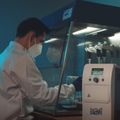Accelerating Monkeypox and SARS-CoV-2 Virus Whole Genome Sequencing Using Combination of NextGenPCR and Oxford Nanopore.....Towards Real-Time Genomic Surveillance
Rapid genomic surveillance of pathogens can provide valuable insights, in order to guide public health interventions. Novel workflows using nanopore technology enables for real-time sequencing of clinical samples. However, current library preparation workflows are limited and can take up to 5 hours whereby PCR takes around 3,5 hours.
By using NextGenPCR technology it is possible to decrease the PCR library preparation to 27 minutes for the SARS-CoV-2 Midnight protocol from Nikkie Freed et al. While optimizing this SARS-CoV-2 PCR tiling, the world faced a monkeypox pandemic. At the beginning of the pandemic, public health institutes were limited to metagenomics approaches. Using this method, the coverage depth becomes the limiting factor that prevents to multiplex multiple samples on a single flowcell, making sequencing very costly.
A collaboration between AmsterdamUMC (Netherlands), Rigshospitalet Copenhagen (Denmark), and Molecular Biology Systems (Netherlands) resulted in a successful optimalisation and validation of an amplicon-based sequencing approach, inspired by SARS-CoV-2 Midnight protocol and the ARTIC network. This allows labs to increase depth of coverage and multiplex up to 20 samples per flowcell.
Using this fast developed sequencing workflow, we were able to get fast insights of the spread of monkeypox in the region of Amsterdam, which resulted in a publication in Eurosurveillance about the first pediatric case in the Netherlands.
Learning Objectives:
1. Discuss the benefits of having faster Next Generation sequencing data in outbreak settings.
2. Discuss the use of PCR tiling for Monkeypox sequencing.
3. Explain the potential of PCR tiling methodologies for other applications.




